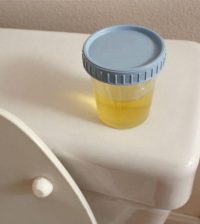- Big Health Care Disparities Persist Across the U.S., New Report Finds
- Teens Often Bullied Online About Their Weight: Study
- Work That Challenges Your Brain Helps You Stay Sharp With Age
- Urine Test Might Spot Head-and-Neck Cancers Early
- Many Seniors Are Overmedicated, But ChatGPT Might Prevent That
- Antipsychotics May Do Great Harm to People With Dementia: Report
- Two-Drug Combo Curbs Drinking for People Battling Severe Alcoholism
- Most Homeless Americans Are Battling Mental Illness
- FDA Recalls Heart Failure Devices Linked to Injuries and Deaths
- COVID Does Not Spur Asthma in Kids, Study Finds
Chemicals in Household Plastics May Raise Risk for Fibroids

Uterine fibroids can cause uncontrolled bleeding and infertility in women, and now a new study finds an unexpected culprit: Toxic chemicals called phthalates that are present in everything from fast-food packaging to plastic water bottles.
“We detected the phthalate DEHP and its breakdown products in much higher quantities in the urine of women who also happen to have symptomatic uterine fibroid tumors. Then we asked the question whether this association was causal. And the answer was yes,” said corresponding study author Dr. Serdar Bulun. He is chair of the department of obstetrics and gynecology at Northwestern University’s Feinberg School of Medicine, in Chicago.
Up to 80% of women will develop one or more fibroids in their lives, some experiencing bleeding, anemia, miscarriages and infertility. Most are non-cancerous.
In the study, the researchers tested primary cells isolated from women’s fibroids. The investigators found that something known as MEHHP, a breakdown product of DEHP, activated a particular cellular pathway that triggered tumor growth.
While previous studies have shown a consistent link between phthalate exposure and fibroid growth, this finding explains how that happens.
DEHP is still widely used in the United States, even with concerns raised about its impact. It is gradually released into the dust and air, and lands on various surfaces.
Fibroids can be found incidentally during a C-section or imaging, as well as discovered after symptoms surface, said Dr. Nathaniel DeNicola, the environmental health expert for the American College of Obstetricians and Gynecologists.
What causes these tumors in the first place is not perfectly understood.
It’s normal for cells to go through a preprogrammed cell death, DeNicola explained, with most adults having somewhere around 50 million cells going through this cell death each and every day. When they don’t die and instead grow, that can cause fibroids or cancer.
DeNicola said based on this study and past research he believes it’s likely these chemicals are contributing to fibroids.
A strength of the study is its use of urine samples from the actual patients and not animal models, he noted.
“When they were comparing association between fibroids and this exposure, they had the biological sample right from the patient,” DeNicola said. “So, that’s a strength.”
Still, this wasn’t a randomized, controlled trial, which is considered the gold-standard for such research.
A piece of good news is that when the researchers looked at the association, they found a u-shaped curve, DeNicola said. With certain levels of exposure, risk was higher.
“But on the low end, you might look to that for maybe some grace with these exposures,” he explained. “It’s really hard to call for, say, zero exposure to something that is as ubiquitous as a chemical that’s in plastic and personal care products, phthalates.”
But people might be able to cut back on their exposure, he noted. Doctors could potentially guide patients on ways to limit phthalate exposure in the same way they do with nutrition.
Policymakers could also regulate personal care products, especially beauty products, with an eye toward limiting racial disparities. DeNicola pointed to past research that found products advertised to women of color had disproportionately high phthalate levels.
For individuals looking for ways to limit exposure in their personal care products, look for those that specifically say they are phthalate-free, he suggested. Look for fragrance-free products rather than those labeled as “unscented,” which may still use phthalates to bind various scents to cancel out an obvious scent. People should also avoid heating their foods up in plastic, DeNicola said.
“I think reasonably it would be impossible” to completely eliminate phthalates through purchases, DeNicola said, but “we want as little as possible.”
Bulun recommended staying away from plastic bottles or plastic food packaging, using glass containers instead. And don’t use PVC products, he advised.
Policymakers can also advocate for and fund more research and legislation, as well as ban plastic bags and bottles, Bulun added.
“In my opinion, this is the most impactful area that should be researched in relation to human health. This is a severely understudied field,” he said.
It is possible the pathway the researchers discovered can be targeted by new therapeutics for uterine fibroids, Bulun suggested.
Uterine fibroids need the hormones estrogen and progesterone for growth. Scientists and physicians should continue to search for alternative temporary measures with minimal side effects to help women minimize ovulation at times when they’re not interested in pregnancy, he said.
“Because in essence, uterine fibroids do not develop without repeated episodes of ovulatory cycles,” Bulun explained.
The findings were published online Nov. 14 in the Proceedings of the National Academy of Sciences.
More information
The U.S. Office on Women’s Heath has more on uterine fibroids.
SOURCES: Serdar Bulun, MD, chair, department of obstetrics and gynecology, Northwestern University Feinberg School of Medicine, Chicago; Nathaniel DeNicola, MD, environmental health expert, American College of Obstetricians and Gynecologists and obstetrician/gynecologist, Johns Hopkins Health System, Baltimore; Proceedings of the National Academy of Sciences, Nov. 14, 2022, online
Source: HealthDay
Copyright © 2024 HealthDay. All rights reserved.










